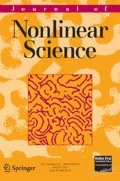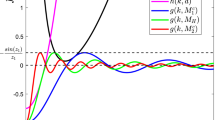Abstract
The most widely used functional response in describing predator–prey relationships is the Holling type II functional response, where per capita predation is a smooth, increasing, and saturating function of prey density. Beddington and DeAngelis modified the Holling type II response to include interference of predators that increases with predator density. Here we introduce a predator-interference term into a Holling type I functional response. We explain the ecological rationale for the response and note that the phase plane configuration of the predator and prey isoclines differs greatly from that of the Beddington–DeAngelis response; for example, in having three possible interior equilibria rather than one. In fact, this new functional response seems to be quite unique. We used analytical and numerical methods to show that the resulting system shows a much richer dynamical behavior than the Beddington–DeAngelis response, or other typically used functional responses. For example, cyclic-fold, saddle-fold, homoclinic saddle connection, and multiple crossing bifurcations can all occur. We then use a smooth approximation to the Holling type I functional response with predator mutual interference to show that these dynamical properties do not result from the lack of smoothness, but rather from subtle differences in the functional responses.
Similar content being viewed by others
References
Arditi, R., Ginzburg, L.R.: Coupling in predator–prey dynamics: ratio-dependence. J. Theor. Biol. 139, 311–326 (1989)
Bazykin, A.D.: Nonlinear Dynamics of Interacting Populations. World Scientific, Singapore (1998)
Beddington, J.R.: Mutual interference between parasites or predators and its effect on searching efficiency. J. Anim. Ecol. 44, 331–340 (1975)
Cantrell, R.S., Cosner, C.: On the dynamics of predator–prey models with the Beddington–DeAngelis functional response. J. Math. Anal. Appl. 257, 206–222 (2001)
Cantrell, R.S., Cosner, C., Ruan, S.: Intraspecific interference and consumer–resource dynamics. Discrete Contin. Dyn. Syst., Ser. B 4(3), 527–546 (2004)
Chen, W., Wang, M.: Qualitative analysis of predator–prey models with Beddington–DeAngelis functional response and diffusion. Math. Comput. Model. 42, 31–44 (2005)
Clarke, F.H., Ledyaev, Y.S., Stern, R.J., Wolenski, P.R.: Nonsmooth Analysis and Control Theory. Springer, New York (1998)
Cui, J., Takeuchi, Y.: Permanence, extinction, and periodic solution of predator–prey system with Beddington–DeAngelis functional response. J. Math. Anal. Appl. 317, 464–474 (2006)
DeAngelis, D.L., Goldstein, R.A., O’Neill, R.V.: A model for trophic interactions. Ecology 56, 881–892 (1975)
Dimitrov, D.T., Kojouharov, H.V.: Complete mathematical analysis of predator–prey models with linear prey growth and Beddington–DeAngelis functional response. Appl. Math. Comput. 162, 523–538 (2005)
Doedel, E., Champneys, A.R., Fairgrieve, T., Kuznetsov, Y., Oldeman, B., Paffenroth, R., Sandstede, B., Xang, X., Zhang, C.: Auto-07p: Continuation and bifurcation software for ordinary differential equations. Tech. rep., Concordia University (2006)
Ermentrout, B.: Simulating, Analyzing, and Animating Dynamical Systems: A Guide to XPPAUT for Researchers and Students. SIAM, Philadelphia (2002)
Gutierrez, A.P.: Applied Population Ecology: A Supply-Demand Approach. Wiley, New York (1996)
Holling, C.S.: The components of predation as revealed by a study of small mammal predation of the European pine sawfly. Can. Entomol. 91, 293–320 (1959a)
Holling, C.S.: Some characteristics of simple types of predation and parasitism. Can. Entomol. 91, 385–398 (1959b)
Hwang, T.W.: Global analysis of the predator–prey system with Beddington–DeAngelis functional response. J. Math. Anal. Appl. 281, 395–401 (2003)
Hwang, T.W.: Uniqueness of limit cycles of the predator–prey system with Beddington–DeAngelis functional response. J. Math. Anal. Appl. 290, 113–122 (2004)
Leine, R.I.: Bifurcations of equilibria in non-smooth continuous systems. Physica D 223, 121–137 (2006)
Leine, R.I., Nijmeijer, H.: Dynamics and Bifurcations of Non-Smooth Mechanical Systems. Springer, Heidelberg (2004)
Leine, R.I., van Campen, D.H.: Bifurcation phenomena in non-smooth dynamical systems. Eur. J. Mech. A, Solids 25, 595–616 (2006)
Liu, S., Beretta, E.: A stage-structured predator–prey model of Beddington–DeAngelis type. SIAM J. Appl. Math. 66(4), 1101–1129 (2006)
Lotka, A.J.: Elements of Physical Biology. Williams & Wilkins, Baltimore (1925)
Murdoch, W.W., Briggs, C.J., Nisbet, R.M.: Consumer–Resource Dynamics. Princeton University Press, Princeton (2003)
Negi, K., Gakkhar, S.: Dynamics in a Beddington–DeAngelis prey–predator system with impulsive haresting. Ecol. Model. 206, 421–430 (2007)
Rosenzweig, M.L.: Paradox of enrichment: destabilization of exploitation ecosystems in ecological time. Science 171, 385–387 (1971)
Rosenzweig, M.L., MacArthur, R.H.: Graphical representation and stability conditions of predator–prey interactions. Am. Nat. 97, 209–223 (1963)
Seo, G., Kot, M.: A comparison of two predator–prey models with Holling’s type I functional response. Math. Biosci. 212, 161–179 (2008)
Turchin, P.: Complex Population Dynamics: A Theoretical/Empirical Synthesis. Princeton University Press, Princeton (2003)
van Voorn, G.A.K., Stiefs, D., Gross, T., Kooi, B., Feudel, U., Kooijman, S.: Stabilization due to predator interference: comparison of different analysis approaches. Math. Biosci. Eng. 5(3), 567–583 (2008)
Volterra, V.: Fluctuation in the abundance of a species considered mathematically. Nature 118, 558–560 (1926)
Author information
Authors and Affiliations
Corresponding author
Additional information
Communicated by P. Newton.
Rights and permissions
About this article
Cite this article
Seo, G., DeAngelis, D.L. A Predator–Prey Model with a Holling Type I Functional Response Including a Predator Mutual Interference. J Nonlinear Sci 21, 811–833 (2011). https://doi.org/10.1007/s00332-011-9101-6
Received:
Accepted:
Published:
Issue Date:
DOI: https://doi.org/10.1007/s00332-011-9101-6
Keywords
- Predator–prey model
- Non-smooth system
- Homoclinic saddle connection bifurcation
- Global bifurcation
- Multiple crossing bifurcation




